#indian birding tours
Explore tagged Tumblr posts
Text
#wildlife#indian wildlife#nature#best indian wildlife photographer#wild#nature photography#wildlife photography#indian wildlife safari#indian wildlife photographer#bird#kaziranga#kaziranga photo tour#kaziranga national park
15 notes
·
View notes
Text
Wildlife Tour Package | All India Birding Tours
Embark on an unforgettable adventure with Asian Adventures' Wildlife Tour Package and All India Birding Tours! Immerse yourself in the mesmerizing beauty of India's diverse wildlife and bird species while exploring some of the country's most renowned natural habitats.
Our Wildlife Tour Package is designed to provide you with an authentic and enriching wildlife experience. Whether you're a seasoned wildlife enthusiast or a nature lover looking for an exciting getaway, our tours cater to all levels of interest and expertise. From the majestic Bengal tigers of Ranthambore National Park to the rare Asiatic lions of Gir National Park, our expert guides will take you on thrilling safaris to witness these magnificent creatures in their natural habitats.
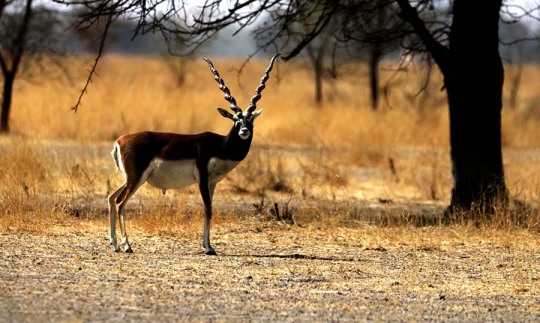
For birding enthusiasts, our All India Birding Tours offer a unique opportunity to spot a wide variety of avian species across India's diverse landscapes. From the colorful migratory birds of Bharatpur Bird Sanctuary to the endemic species of the Western Ghats, our tours are curated to showcase the rich birdlife that India has to offer. With experienced birding guides and well-planned itineraries, you'll have the chance to capture stunning photographs and learn about the fascinating behavior and habitats of each species.
At Asian Adventures, we prioritize responsible tourism and conservation efforts. Our tours are conducted in eco-friendly ways to minimize our impact on the environment, and we support local communities and conservation projects to ensure the long-term protection of India's wildlife and natural resources.
Join us on a journey of discovery and awe-inspiring encounters with Asian Adventures' Wildlife Tour Package and All India Birding Tours. Whether you're seeking adrenaline-pumping wildlife sightings or peaceful moments in nature, our tours promise an unforgettable experience that will leave you with cherished memories for a lifetime.
Book your adventure today and let Asian Adventures be your guide to the wonders of India's wildlife and birding paradise!
#indian wildlife tours#birding tours in india#india birding tours#wildlife and birding tours#family holiday packages in india
0 notes
Text
Check out this post… "Peacock: Description and Habitat".


#articles#article#geography#world tour#blogger#blogpost#beautiful#facebookpage#moveon#birdsofinstagram#peacock#national bird day#amazing#wow wow wow#indian#my blogs
0 notes
Note
Hi there. Idk if this question has been asked before, but where do they find the fabric for the mandarin coat?
I'd say there are as many answers as there are versions of the costume. But some pointers:
Many of the early versions were made with partly antique embroidered textiles from the Qing dynasty. These were a popular collector's item in the 19th and 20th century, to the point where some of them were never intended for use in China, they were made as souvenirs. The original design by Maria Bjørnson suggests antique Chinese fabrics, with a hem showing the classic water-and-mountain motif, the collar being a cloud collar usually seen in women's attires, and the hat a decorated winter hat.

Even if all these costumes are made from scratch rather than bought, I thought it could be interesting to compare it to a similar authentic Chinese robe - without the collar - dated to the 1890s and sold by Augusta Auctions some years ago:

This robe has a badge - an insignia of rank and position of a Mandarin official in the Qing dynasty. These were used both on the chest and back, and the bird or otherwise animal told onlookers all they needed to know, if the person was a civil or military employee, and how high up in the system they were. The badge is not featured in Bjørnson's design, but it has showed up in a few costumes. Maybe most proninently in Michael Crawford's original West End costume, which Bjørnson would have supervised:

To my eye it looks like many of the elder costumes (up until c. 2005) used a lot of antique or vintage fabrics, but used on a new base. Details to look for is distinct gold couching, re-used badges, special dragon embroideres, antique collars and tabards, fringework etc. I am quite convinced some of these are antique or vintage details, like the China blue tabard with water and mountain motif used by John Owen-Jones in West End c. 2002:
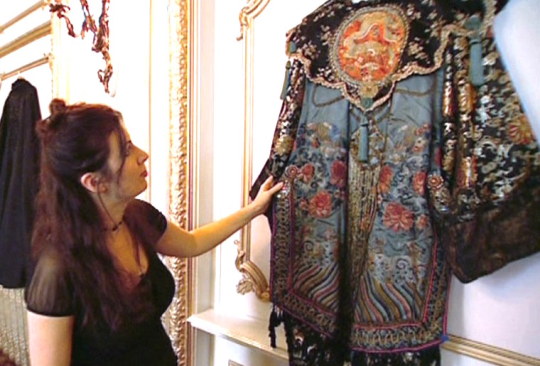
The cuff and details on one of the original Australian robes, and continued to shine in the World Tour up until 2015 or so:
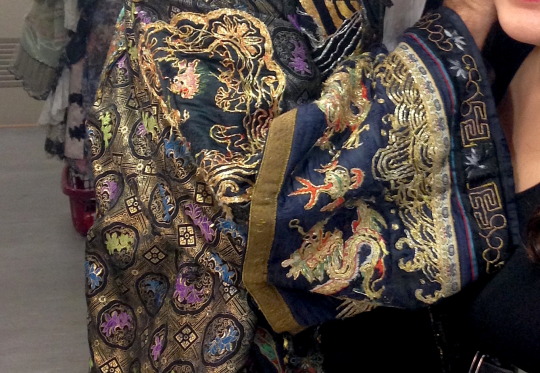
The tabard of the Swedish/Danish version, first made in 1989 and still in use in 2019 (maybe not too visible in the stage photo, but definitely when seen up close backstage!):

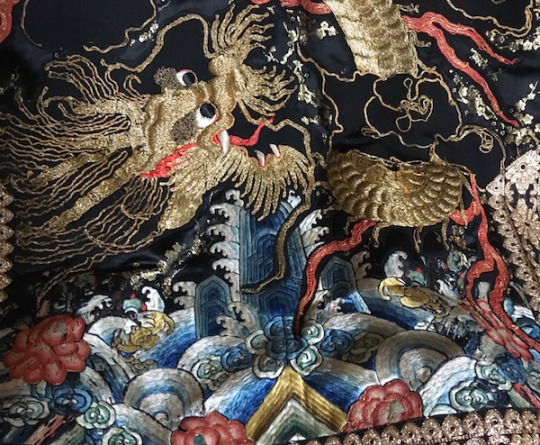
As a contrast, newer costumes tends to be brassier and bigger, with less embroidery and more appliquées and trims. It looks to me like they mostly rely on new fabrics and materials, maybe with some elements of elder embroidery. This collar made for Ben Lewis in West End is a good example:
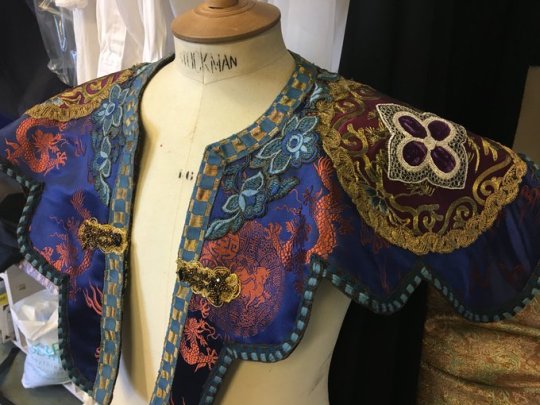
And the recent German version, here seen on Mathias Edenborn in Hamburg. It's a costume I got to study up close and I couldn't spot any particular details that looked old:

And this Broadway robe with what looks like a very new firefly pattern brocade and embroidered gold trims appliquéed on:

So why this change? I guess it depends on what is available. Qing textiles has become more rare on the open market, and more expensive. Elder textiles are also more fragile, while new textiles will handle wear and tear, dry cleaning etc. better. Some of these costumes are used on stage up to eight times a week, after all.
Due to the fragility of elder textiles, they may have to cover the embroidery with fine mesh. This dulls down the effect and makes the costume heavier, so it's not always ideal. Better then to use new stuff. Here's an early 1990 West End one covered with mesh, to protect the embroidery:

A last aspect is of course that by using elder textiles you may put specific meaning-bearing motifs on which ideally shouldn't be there. The beautiful embroidered Indian fabric with elephants and swastikas - in India a symbol of the sun and good luck - which appeared in an unfortunate Danish Elissa skirt is a good example. Luckilly the costume crew knew what they were doing by including the five bats - for good luck - on this Broadway Mandarin robe:

If you plan on making your own costume, I would say: Create the base of a Chinese brocade (silk or synthetic) with predominantely black or dark blue base and polychrome pattern. As an inspiration, here's the robe, collar and tabard - fairly undecorated - in making for Scott Davies (top) and Ben Lewis (bottom) in West End, with photos generously shared by head-of-costume Ceris Donovan:


For the back: Go for a main motif, and build everything around that. And layer! Gems upon trims upon embroideries upon fabrics. The more structure, embroidery, couching and details the various materials has, the better. And then add some on top of that.
Note that it varies if a production do both the robe, cloud collar and tabard. Some production only do two of these, some do all three. But whatever the case, the costume with hat should create angles, texture and lines that makes him stand out from the previous scene, where he wore black and white and tight-fitting clothes.

In West End I think they source it in the many amazing fabric shops in Brixton and Soho, including Borovicks, as well as antique dealers. For Broadway I know a lot was bought in the fabric district in NYC. Other productions may be equipped with fabrics and trims from these, or they may source their own materials locally. I also noticed that the Chinese (left) and Japanese (right) productions tend to use more red and purple fabrics for their versions, which I would think was also locally sourced:

So yeah. As many answers as there are versions out there...
61 notes
·
View notes
Note
Hey! Hope you're doing good!! :) I'm wondering if you know any Drarry fics that have mythological elements / stories as part of the plot. For example, a fic based on Greek myths like Hades/Persephone?
Hi anon! I’m doing great, what about you? :) oh that’s a really cool ask, I hope you enjoy these! I strongly recommend checking khalulu’s stuff as they always explore different mythologies and cultures across their works. I’d love to get more recs on this theme, too!
Nordic:
Veðr by @shealwaysreads (M, 3k)
Norsemen have ranged far enough inland to find Harry, alone and abandoned by his kith and kin. But they bring far more than danger with them, they bring adventure, they bring magic.
Swedish:
Sweden | A Midsummer Night’s Dream by @drarrelie (M, 5.5k)
With the war finally over, you’d think Harry would finally be granted that “normal life” he’s always dreamt about. Finally free from the Dursleys, from that nose-less megalomaniac, from Horcruxes, Hollows, Death Eaters, Dementors, Prophecies… you’d think that he, for the first time in his life, would be allowed to be just a normal teenager. You’d think he’d deserve that much, right?
Russian:
S’Mitten by khalulu (G, 6k)
Harry and Draco aren’t enemies any more, but it seems their history will always stand between them – so let’s try some other histories on for size! The fickle finger of fate is muffled in one of Mrs Weasley’s mittens. Did I mention kisses?
Norwegian:
East of the Sun and West of the Moon by khalulu (T, 6k)
One stormy Thursday evening, a big white bear named Draco turns up to carry Harry away from the dreadful Dursleys. They get along fairly happily together until one night Harry’s curiosity gets the better of him, and Draco is whisked away to his wicked aunt’s castle, East of the Sun and West of the Moon. It will take a strong wind to bring Harry that far…..
Albanian:
What Country, Friends, Is This? by khalulu (M, 8k)
When Harry and Draco are paired up for a nebulous “capstone project” in 8th year, Draco suggests they use it as an opportunity to take a free Grand Tour of Europe. Harry isn’t interested in being grand, and they soon veer off the beaten path. The journey to find what (and who) you really want can lead to unexpected places. (As well as Bertha Jorkins’ aunt, Illyrian Serpent cults, heroic baby Draco tales, and Slytherins singing Motown.)
Hindu:
Birds of Dreams / Remover of Obstacles / Guardian of Waters by khalulu (G, 12k)
Harry is exploring his Desi heritage, and Draco runs into him in colourful circumstances. Luna has a penchant for puns and the Patils watch Bollywood. Paper is folded, a flying carpet takes an Indian road trip, and a phoenix is found. Love blooms along the way, a flower that’s free.
Finnish:
Sparks from the Fox’s Tail by khalulu (T, 17k)
Draco is frustrated with his career as a travel writer, when a mini-tirade from Mrs Weasley and an encounter with the portrait of an intrepid great-great-great-aunt lead him to Finland to study wandless magic. Harry is – just being contrary and following his sweet-tooth, or taking the subtle route to saving the world?
Multiple:
The Hardest Hue To Hold by @cavendishbutterfly (M, 17k)
Harry needs to get the hell out of England. So he sets up a teaching assistantship in America, hops on a plane, and heads off to a fresh start. Except there’s a familiar face among the university faculty, and it’s really not the familiar face that Harry wanted. Or at least, it’s not who Harry wanted at first.
Irish:
Offer Up Our Hearts by @tackytigerfic (M, 23k)
Harry Potter has a very nice life, thank you very much. He's a top Curse-Breaker with a lucrative Ministry contract, and exciting prospects ahead. Sometimes he does wish that he had time to pursue something official with Draco Malfoy - they're half in love with each other, after all, and a great team (in and out of bed), though Draco is still one of the most infuriating people he knows.
Egyptian:
Memory Lost | You Found by @maraudersaffair (E, 30k)
After his Auror training, Harry's assigned to guard the Department of Mysteries - specifically the room where Malfoy is being held in comfortable captivity. Yet no one will tell him why, and what's more concerning? Malfoy doesn't remember Harry at all. To uncover the mystery, Harry must travel all the way to Egypt where he discovers a magical community living in the great pyramids and a long held secret that is dangerous to anyone who knows it.
Arthurian:
The Compact by astolat (E, 64k)
Hermione frowned. “The real question is why the magic of Britain would be failing now, in fact.” “That is not the real question!” Ron said loudly; he’d woken up fully by now, and Harry had too; it was starting to sink in that they’d found the problem. “The real question is, how do we fix it?”
Brazilian:
A Sense of Scale by @fantalfart and dragontamerdrarry (M, 70k)
In which Draco spends an obscene amount of time thinking of new nicknames for The Living Git, lying to himself and using his charms to seduce an extremely uncooperative sentient school.
Celtic:
The Stars Have Courage by @fantalfart (M, 85k)
Draco waited five long years to watch his husband wake up from a coma. He's not ready to meet a Harry with no memory of anything that happened after he died at The Battle of Hogwarts, twelve years ago.
Greek:
Close Behind by @oflights (M, 134k)
To rescue Draco from the Underworld, Harry has to look forward. Unfortunately, Draco has to look back.
Bonus: dark fae AU 🧚♂️
Mushrooms of Wiltshire by @shiftylinguini (T, 5k)
There's no point unpacking―Harry's not staying long, and besides, there's just bundled rags in his valise. The illusion of belongings, of a man heading to a new position at a prestigious manor―one beset with rumours of old magic and of impish forest dwellers causing chaos and mayhem amid the phosphorescent toadstool glow. Bugger the job. Harry's here for the rumours. He's been chasing them for years.
108 notes
·
View notes
Text
Holidays 11.13
Holidays
Actor’s Day
Advocacy Action Day
Blame Someone Else Day
Brassiere Day
Canterbury Day (New Zealand)
Caregiver Appreciation Day
Day of Radiological, Chemical and Biological Defense Troops (Russia)
Geographic Information Systems Day
International Day of Huntington’s Disease
International Schinzel-Giedion Syndrome Awareness Day
Lhabab Duechen (Bhutan)
Madder Day (French Republic)
Mister Rogers Cardigan Day
National Community Education Day
National Dream Destination Day
National Hug a Musician Day
National Japanese Culture Day
National Mom’s and Dad’s Day
National Reread Old Letters and Magazines Day
National Saddle Hunting Day
National Sunflower Day (South Africa)
Njegos Day (Montenegro)
Odd Couple Day
Odd Socks Day (UK)
Quasihomosexual Pride Day
Sadie Hawkins Day [also 11.15 & 1st Saturday]
Start a Rumor Day
Swiftie Day
Symphonic Metal Day
Tree Festival Day (Tunisia)
Tree Day (Macedonia)
World Kindness Day
Food & Drink Celebrations
Frankfurter Day
Indian Pudding Day
National Bread Pudding Day
National Chicken Nugget Day
National Roast Dinner Day (UK)
National Sea Salt Caramel Day
World Mediterranean Diet Day
Independence & Related Days
Politzania Independence Day (Klaatu)
2nd Wednesday in November
Blue Wednesday [2nd Wednesday]
Buß- und Bettag (Day of Repentance and Prayer; Bavaria, Saxony) [2nd Wednesday before 1st Sunday in Advent]
Hump Day [Every Wednesday]
International Pathology Day [2nd Wednesday]
National CTEPH Awareness Day [2nd Wednesday]
Wacky Wednesday [Every Wednesday]
Watermelon Wednesday [2nd Wednesday of Each Month]
Website Wednesday [Every Wednesday]
Workout Wednesday [2nd Wednesday of Each Month]
Weekly Holidays beginning November 13 (2nd Full Week of November)
Geography Awareness Week (thru 11.17)
World Kindness Week (thru 11.19) [Week Starting 11.13]
Festivals Beginning November 13, 2024
Cairo International Film Festival (Cairo, Egypt) [thru 11.22]
Country Living Christmas Fair (London, United Kingdom) [thru 11.16]
Rock the Bells Cruise (Miami, Florida) [thru 11.17]
Feast Days
Abbo of Fleury (Christian; Saint)
Agostina Livia Pietrantoni (Christian; Saint)
Arcadius and His Companions (Christian; Martyrs)
Barneveldt (Positivist; Saint)
Benny Andrews (Artology)
Bertel Thorvaldsen (Artology)
Brice of Tours (Christian; Saint)
Charles Simeon (Church of England)
Chillen (a.k.a. Killian; Christian; Saint)
Chuang Tzu’s Day
Constant (Christian; Saint)
Cranberry Sparkle Cake Day (Starza Pagan Book of Days)
The Dangerous Dragon (Muppetism)
Death-Watch (Celtic Book of Days)
Didacus (Diego) of Alcalá (Christian; Saint) [Cooks]
Epulum Iovis (Festival of Feronia, Juno, Minerva and Jupiter; Ancient Rome)
Eugenius II of Toledo (Christian; Saint)
Feast of Feronia (a.k.a. Epulum Iovis; Old Etruscan and Roman Fertility Goddess)
Feast of Hundred Thousand Martyrs of Tbilisi (Georgia)
Feast of the Saints of the Premonstratensian Order (Roman Catholic)
Festival of Feronia (Ancient Roman Goddess of Wildlife, Fertility, Health & Abundance)
Festival of Jupiter (Ancient Rome)
Fontinalia (Festival to Fons, Spirit of Springs; Pagan)
Fortuna Primigenia (Fortune of the Firstborn; Ancient Rome)
Frances Xavier Cabrini (Christian; Saint)
George V. Higgins (Writerism)
Homobonus (Christian; Saint)
The Hundred Thousand Martyrs of Tbilisi (Georgian Orthodox Church)
Ides of November (Ancient Rome)
John Chrysostom (Eastern Orthodox, Repose)
Kilian (Christian; Saint)
Leandro (Christian; Saint) [Spain]
Maxellendis (Christian; Virgin & Martyr)
Mitrius (Christian; Saint)
Nicholas I, Pope (Christian; Saint)
Otis Campbell Day (Church of the SubGenius; Saint)
Quintian of Rodez (Christian; Saint)
Rivkah (Artology)
Robert Louis Stevenson (Writerism)
Saints of the Benedictine family (Christian; Saints)
Saints of the Premonstratensian Order (Christian; Saints)
Stanislaus Kostka (Christian; Saint)
Stephen Baxter (Writerism)
Talk to Birds Day (Pastafarian)
Tooth Collection Days begin (Fairies; Shamanism)
William Gibson (Writerism)
Lucky & Unlucky Days
Butsumetsu (仏滅 Japan) [Unlucky all day.]
Day of Darkness, Evil & Misfortune (Medieval Europe) [13th Day after Halloween)
Prime Number Day: 317 [66 of 72]
Premieres
Aladdin (Animated Disney Film; 1992)
An Arrow Escape (Terrytoons Cartoon; 1936)
Beauty Shoppe (Ub Iwerks Cartoon; 1940)
Bram Stoker’s Dracula (Film; 1992)
The Bush Pusher or Beri Beri Who’s Got the Berry? (Rocky & Bullwinkle Cartoon, S4, Ep. 178; 1962)
Caroline Lamb (Writerism)
Double Danger (Animated TV Show;Jonny Quest #9; 1964)
Downhearted Duckling (Tom & Jerry Cartoon; 1954)
Enough Stupidity in Every Wise Man, by Aleksandr Ostrovsky (Play; 1868)
Fantasia (Animated Disney Film; 1940)
Fantastic Mr. Fox (Stop Motion Film; 2009)
The Forty Thieves (Terrytoons Cartoon; 1932)
Hairied and Hurried (WB MM Cartoon; 1965)
Heart of Darkness, by Joseph Conrad (Novel; 1902)
Laundry Service, by Shakira (Album; 2001)
Laura, by Vera Caspary (Novel; 1942)
The Lightning Bugs or Nuts and Volts (Rocky & Bullwinkle Cartoon, S4, Ep. 177; 1962)
The Line, The Cross & The Curve, by Kate Bush (Short Film; 1993)
Lionheart, by Kate Bush (Album; 1978)
Lose Yourself, by Eminem (Song; 2002)
Mountain Mover or Boris Sneaks a Peak (Rocky & Bullwinkle Cartoon, S2, Ep. 72; 1960)
An Old-Fashioned Love Song, by Three Dog Night (Song; 1971)
1, by The Beatles (Compilation Album; 2000)
Out of the Past (Film; 1947)
Out of This Whirl (Noveltoons Cartoon; 1959)
Porky’s Double Trouble (WB LT Cartoon; 1937)
Rocky and the Rock or Braver and Boulder (Rocky & Bullwinkle Cartoon, S2, Ep. 71; 1960)
The Saint in Pursuit, by Fleming Lee (Short Stories; 1970) [Saint #43]
Scooby-Doo and the Reluctant Werewolf (Hanna-Barbera Animated TV Movie; 1988)
A Short History of Decay, by Emil M. Cioran (Science Book; 1949)
Silent Night, recorded by Bing Crosby (Song; 1935)
Ski for Two (Woody Woodpecker Cartoon; 1944)
2012 (Film; 2009)
War and Remembrance (TV Mini-Series; 1988)
Where the Wild Things Are, by Maurice Sendak (Children’s Book; 1963)
Whistler’s Father, Parts 1 & 2 (Underdog Cartoon, S2, Eps. 33 & 34; 1965)
Yellow Submarine (Animated Film; 1968)
Today’s Name Days
Eugen, Livia, Stanislaus (Austria)
Brcko, Brickije, Didak, Dobroslav, Homobonus, Ivan, Mitar, Stanislav, Stanko (Croatia)
Tibor (Czech Republic)
Arcadius (Denmark)
Krister, Kristjan, Kristo, Risto (Estonia)
Ano, Kristian (Finland)
Brice (France)
Eugen, Livia, Stanislaus, Rene (Germany)
Chrysostomos, Damaskinos, Hrysostomos (Greece)
Szilvia (Hungary)
Brizio, Diego, Omobono, Paterniano (Italy)
Eižens, Jevgēņija, Jevgēņijs, Taida (Latvia)
Arkadijus, Eirima, Norvydas (Lithuania)
Kirsten, Kirsti (Norway)
Arkadiusz, Arkady, Brykcjusz, Eugeniusz, Jan, Mikołaj, Stanisław, Walentyn (Poland)
Ioan (România)
Stanislav (Slovakia)
Diego, Leandro (Spain)
Krister, Kristian (Sweden)
Brice, Bruce, Bryce, Bryson, Stan, Stanford, Stanley (USA)
Today is Also…
Day of Year: Day 318 of 2024; 48 days remaining in the year
ISO: Day 3 of Week 46 of 2024
Celtic Tree Calendar: Hagal (Hailstone) [Day 18 of 28]
Chinese: Month 10 (Yi-Hai), Day 13 (Xin-Si)
Chinese Year of the: Dragon 4722 (until January 29, 2025) [Wu-Chen]
Hebrew: 12 Heshvan 5785
Islamic: 11 Jumada I 1446
J Cal: 18 Wood; Threesday [18 of 30]
Julian: 31 October 2024
Moon: 93%: Waxing Crescent
Positivist: 10 Frederic (12th Month) [Gustavus Adolphus]
Runic Half Month: Nyd (Necessity) [Day 7 of 15]
Season: Autumn or Fall (Day 52 of 90)
Week: 2nd Full Week of November
Zodiac: Scorpio (Day 21 of 30)
2 notes
·
View notes
Text
Ranthambore National Park: A Journey into India’s Wildlife Haven

The Allure of Ranthambore National Park: A Wildlife Wonderland
Ranthambore National Park, situated in the vibrant state of Rajasthan, is a captivating destination that offers an extraordinary glimpse into India’s wildlife heritage. Known for its dramatic landscapes and diverse ecosystems, this national park is a dream come true for nature enthusiasts and adventure seekers alike. Here are some compelling reasons to visit Ranthambore.
1. Encounter the Iconic Bengal Tiger
Ranthambore is one of the premier locations in India for spotting the elusive Bengal tiger. The thrill of observing these magnificent creatures in their natural environment is unmatched. From the excitement of a tiger sighting during a safari to hearing their distant roars echoing through the jungle, every moment spent in the park is filled with anticipation.
2. Diverse Wildlife Experience
Beyond tigers, Ranthambore is home to a rich variety of wildlife. The park is teeming with species such as leopards, sloth bears, wild boars, and over 300 bird species. This incredible biodiversity makes it a paradise for wildlife lovers and bird watchers, providing endless opportunities for exploration and discovery.
3. Stunning Natural Landscapes
Ranthambore's breathtaking landscapes are a feast for the eyes. The park features a unique blend of rugged hills, lush forests, and tranquil lakes, creating a picturesque backdrop for your adventures. The ancient Ranthambore Fort, perched high on a hill, offers stunning views of the surrounding wilderness and adds a historical touch to your visit.
4. Adventure Awaits
For those seeking adrenaline-fueled experiences, Ranthambore has plenty to offer. Jeep safaris and canter rides allow you to traverse the park’s diverse terrain and get up close to its wildlife. Additionally, guided nature walks provide a more intimate way to explore the flora and fauna, perfect for photographers and nature lovers.
5. Rich Cultural Experiences
Ranthambore is steeped in culture and tradition. The surrounding villages offer visitors a chance to experience local customs and lifestyles. Engage with friendly locals, taste authentic Rajasthani cuisine, and shop for unique handicrafts. These cultural encounters enrich your journey and provide insight into the vibrant heritage of the region.
6. Tailored Tour Packages
To ensure a seamless experience, consider booking a tour package that caters to your interests. Various options are available, including wildlife-focused safaris and cultural explorations. For comprehensive travel packages designed to enhance your visit, check out Indian Inspire Journey's Ranthambore tour packages. These packages make it easy to navigate the park’s offerings, allowing you to relax and enjoy your adventure.
7. Commitment to Conservation
Ranthambore National Park is a shining example of successful wildlife conservation. By visiting, you support efforts to protect the region's unique ecosystems and promote sustainable tourism. Your trip helps ensure that future generations can experience the wonders of Ranthambore.
Conclusion
Ranthambore National Park is a remarkable destination that combines thrilling wildlife encounters, stunning landscapes, and rich cultural experiences. Whether you’re a wildlife enthusiast, a photographer, or a curious traveler, Ranthambore promises an unforgettable adventure. To start planning your journey, explore the Ranthambore tour packages offered by Indian Inspire Journey and prepare for an experience that will leave you in awe of nature’s beauty.
2 notes
·
View notes
Text
Best Cottages in Rishikesh Near Ganga-The Neeraj Ganga Cottages

Rishikesh, often referred to as the "Yoga Capital of the World," is a city that blends spirituality, adventure, and natural beauty in a way few places on Earth can. Nestled along the sacred Ganges River, it has become a go-to destination for travelers seeking peace, relaxation, and adventure alike. If you're looking to enhance your experience with a luxurious stay, then the best cottages in Rishikesh near Ganga are exactly what you need. Among them, The Neeraj Ganga Cottages stand out as a perfect choice for anyone seeking comfort, stunning views, and a serene atmosphere.
Why Choose a Cottage in Rishikesh Near Ganga?
When visiting Rishikesh, staying near the Ganges offers an unparalleled experience. The river, considered holy in Hinduism, is not just a source of spiritual rejuvenation, but also a place where nature flourishes. Imagine waking up to the sound of the river’s soft currents, the chirping of birds, and the view of lush greenery. The Neeraj Ganga Cottages offer exactly that, combining the best aspects of both spirituality and luxury.
Choosing a cottage near the Ganges is ideal for anyone who wishes to experience Rishikesh in its truest form. Whether you're attending yoga retreats, seeking adventure in the nearby forests and rivers, or simply wanting to relax, staying in one of the best cottages in Rishikesh near Ganga, such as The Neeraj Ganga Cottages, will undoubtedly elevate your experience.
The Neeraj Ganga Cottages: A Glimpse of Luxury in Rishikesh
Unparalleled Location
The Neeraj Ganga Cottages are located in close proximity to the Ganges, offering visitors direct access to the riverbank. This makes it a perfect spot for those who wish to take a morning dip in the holy waters or simply enjoy the mesmerizing sunsets by the river. Moreover, the cottages are a short distance from the famous landmarks of Rishikesh, including Laxman Jhula, Ram Jhula, and various ashrams like Parmarth Niketan. You’re close to everything, yet far enough to enjoy the peace and quiet.
Luxury and Comfort Redefined
These cottages redefine luxury. Despite being close to nature, The Neeraj Ganga Cottages provide guests with all the modern amenities one would expect from a high-end resort. The rooms are spacious and elegantly furnished, blending traditional Indian design with modern comfort. The interiors have been crafted with natural materials, making sure the ambiance complements the surroundings. Additionally, each cottage has its own private balcony where guests can sit and enjoy the stunning view of the river and the Himalayan foothills.
Personalized Services
What sets The Neeraj Ganga Cottages apart from other accommodations is their personalized service. Guests are treated with utmost care, and no request is too big or small. Whether it’s arranging a guided yoga session by the Ganga, booking adventure tours, or organizing a private puja (prayer ritual), the staff ensures that your stay is tailored to your needs. This personal touch adds to the overall luxurious experience, making it one of the best cottages in Rishikesh near Ganga.
The Best Cottages in Rishikesh: A Guide to Choosing the Perfect Stay
While there are many accommodations available in Rishikesh, cottages offer a unique combination of privacy, luxury, and closeness to nature. Here’s why The Neeraj Ganga Cottages top the list:
Proximity to Nature
Unlike hotels that are often located in bustling areas, cottages like The Neeraj Ganga Cottages allow you to immerse yourself in nature. Surrounded by the sounds of the river and the vibrant greenery, you'll feel a deep connection to the environment.
Privacy and Seclusion
For travelers who value privacy, cottages are the ideal choice. The Neeraj Ganga Cottages are spread out, ensuring that each guest enjoys their own space without disturbance from other visitors. This seclusion makes the cottages perfect for those looking to meditate, practice yoga, or simply unwind.
Luxurious Amenities
Despite being nestled in nature, The Neeraj Ganga Cottages offer all the modern conveniences you need for a comfortable stay. Air-conditioning, plush bedding, Wi-Fi, room service, and more are provided, ensuring that guests can relax in luxury after a day of exploring Rishikesh.
What to Do While Staying in the Best Cottages in Rishikesh Near Ganga
Yoga and Meditation Retreats
Rishikesh is world-renowned for its yoga and meditation retreats. Staying in a cottage near the Ganges, such as The Neeraj Ganga Cottages, puts you in close proximity to some of the best yoga centers and ashrams in the region. Whether you're a beginner or an experienced practitioner, you can find a retreat that suits your needs.
River Rafting and Adventure Sports
For the adventure seekers, the best cottages in Rishikesh near Ganga offer easy access to thrilling activities such as white-water rafting, bungee jumping, and trekking. The Ganges is famous for its rafting experience, especially during the post-monsoon months when the river flows at its strongest.
Spiritual Experiences
The Neeraj Ganga Cottages are close to the famous ghats (riverbanks) where the Ganga Aarti, a Hindu prayer ceremony, takes place. Watching this ceremony, where hundreds of devotees gather to offer their prayers to the Ganges, is a truly spiritual experience.
Wellness and Spa Treatments
After a long day of exploration or spiritual practice, pamper yourself with wellness treatments offered by The Neeraj Ganga Cottages. With their in-house spa, you can enjoy traditional Ayurvedic massages and treatments that rejuvenate both body and soul.
Best Time to Visit Rishikesh
The best time to visit Rishikesh depends on your preferences. The months from March to June are ideal for those who wish to enjoy pleasant weather, river rafting, and other adventure activities. However, if you're visiting for spiritual reasons or to attend yoga retreats, the cooler months from September to November are more suitable.
How to Reach The Neeraj Ganga Cottages
Located just a few kilometers from Rishikesh's main town, The Neeraj Ganga Cottages are easily accessible by road. The nearest airport is Dehradun’s Jolly Grant Airport, which is approximately 20 km away. From there, you can easily take a taxi or hire a private car to reach the cottages.
Conclusion
For anyone visiting Rishikesh, the combination of spiritual beauty, adventure, and nature makes for an unforgettable experience. And when it comes to staying near the holy Ganges, there’s no better place than The Neeraj Ganga Cottages. These luxury cottages offer the perfect balance of comfort, privacy, and stunning views, making them the best cottages in Rishikesh near Ganga. Whether you're seeking a peaceful retreat or an action-packed adventure, The Neeraj Ganga Cottages are sure to meet your expectations and elevate your stay in this sacred city.
2 notes
·
View notes
Text

John Coltrane Quintet with Eric Dolphy - Kulttuuritalo, Helsinki, Finland, November 22, 1961
A day after this performance, DownBeat's John Tynan wrote: "At Hollywood’s Renaissance Club recently, I listened to a horrifying demonstration of what appears to be a growing anti-jazz trend exemplified by these foremost proponents [Coltrane and Dolphy] of what is termed avant-garde music. I heard a good rhythm section… go to waste behind the nihilistic exercises of the two horns.… Coltrane and Dolphy seem intent on deliberately destroying [swing].… They seem bent on pursuing an anarchistic course in their music that can but be termed anti-jazz."
Time has proven Tynan 100% right, of course — this stuff sucks! Just kidding ... the team-up of Coltrane and Dolphy is one the high water marks of modern music as we know it. At least in my opinion. The four-disc Village Vanguard collection offers one of the most incredible listening experiences you'll find anywhere in any genre. And amazingly, we're going to get more Coltrane / Dolphy (and Jones and Tyner and Workman) in about a month. The previously unreleased Evenings at the Village Gate: John Coltrane with Eric Dolphy features 80 minutes of music recorded a couple months prior to the Village Vanguard stand. Unreal! You can check out a sample over on NPR now and although the recording was made with a single mic (by future Dylan engineer Richard Alderson), it sounds well-nigh miraculous.
While we wait for the rest, let's enjoy this wondrous 40+ minutes of the Coltrane Quintet in Finland. Compared to the Village Vanguard tapes from just a few weeks before, the performance is relatively smooth — nothing too outward bound like "India" or "Chasin' Another Trane." Coltrane had already tested the European audience's stamina on his final tour with Miles in 1960, so maybe he was hedging his bets slightly. But that's not meant as a criticism. This is spectacular music from start to finish. And if this group is deliberately destroying swing on the long and luminous "My Favorite Things" here ... well, then destroy away, dudes! Dolphy's incredible flute solo here is a total showstopper.
"At home [in California] I used to play, and the birds always used to whistle with me," Dolphy said. "I would stop what I was working on and play with the birds ... Birds have notes in between our notes—you try to imitate something they do and, like, maybe it’s between F and F-sharp, and you’ll have to go up or come down on the pitch. It’s really something! And so, when you get playing, this comes. You try to do some things on it. Indian music has something of the same quality— different scales and quarter tones. I don’t know how you label it, but it’s pretty."
Photo: Herb Snitzer/Impulse! Records
32 notes
·
View notes
Note
36, 56 and 57 please!
hi!
36 - three dreams you want to fufill?
i think my main one is performing - i would love to be in a band that actually does gigs & goes on tour & i want to perform for people :] yeagh. i would also love to write a book, even just a small one, & i'd love to act hamlet <3
56 - favourite foods?
ooh uhmmm i do love indian food but i'm well aware thats a very broad category & the indian takeway i get in nz probably isnt the most authentic........ also SEAWEED SALAD i love that stuff hehe
57 - favourite animal?
most kinds of small bird :) i do also really like cats though
3 notes
·
View notes
Text
Tolerance and Capitalism; Slavery and Swindle: the Mixed Legacy of the Dutch in New Amsterdam
— April 5, 2024 | By Wendy Blake

View of New Amsterdam 1664, Watercolor. Photos courtesy of New-York Historical Society
Two remarkable letters are on display in the New-York Historical Society’s installation “New York Before New York: The Castello Plan of New Amsterdam.”
One, a 1626 letter to the Dutch West India Company from an official in New Amsterdam, the seat of colonial government in New Netherland, describes the “purchase” of “the island Manhattes from the Indians for the value of 60 guilders” (converted by a 19th-century historian into $24). That letter is the only record of the infamous transaction.

1626 Letter Describing the “Purchase” of Manhattan.
The second letter, written by present-day Lenape chiefs whose ancestors inhabited the region when the Dutch arrived, declares the “purchase” invalid. Indeed, says Russell Shorto, director of the New Amsterdam Project at NYHS and exhibition curator, who reached out to the tribes for this response, the transaction was a swindle: The Lenape would have viewed the transaction not as a sale but as a land-use treaty, amounting to an economic and defensive alliance with the Dutch. The items valued at 60 guilders (kettles, knives, and such) would not have represented payment for land but gifts typically presented upon the sealing of a treaty.
The chiefs’ letter, addressed to “Ancestor,” decries the 400 years of devastation experienced by the Lenape people but proclaims that the surviving families have reconnected with “The Land and Waters of Manahahtáanung.”
The NYHS exhibition, which marks the 400th anniversary of the arrival of Dutch settlers, brings together rare items that document the ugly legacies of African enslavement and dispossession of Native tribes while also speaking to the valuable contributions of non-Europeans. It also describes two foundational elements of Dutch culture that positively influenced the city we know today.
“The Dutch brought a tolerance that was unusual in Europe at the time—in fact, intolerance was official policy in France, England and Spain,” said Shorto in an interview with the Rag. “You had this mix of people speaking different languages and worshipping different ways. [The Dutch] showed in effect that tolerance of others was a recipe for economic success.”
As inventors of the stock market, they also imported capitalism. “They were a practical, seafaring people, and it was in their interest to have an entrepôt [a global trading post],” said Shorto. “Everyone in New Amsterdam was a trader. They would put money back into particular ventures and voyages.”
Business in the New World centered on the fur trade—particularly the “soft gold” of beaver pelts, which were secured by Native trappers—paving the way for New York to become a commercial hub. But the city would also become a center of the slave trade.

The Castello Plan, Showing the City of New Amsterdam Around 1660.
The earliest known map of New Amsterdam, known as the Castello Plan, is a highlight of the exhibition. Drafted by Jacques Cortelyou, the surveyor general for the Dutch territory in the New World, and illustrated by cartographer Johannes Vingbooms, the map offers a bird’s-eye view of the city at its peak, around 1660. It depicts 300-some houses, home to about 1,500 people; extensive gardens; a windmill; a fort; and a church attended by Christians of many denominations, including enslaved Africans—all south of the fence that would become Wall Street. A 3-D rendering of the map allows visitors to tour the city virtually, taking them down a canal and under bridges.
The map is on loan from the Laurentian Library in Florence, Italy. (It was sold in Amsterdam to Cosimo III de’ Medici, an Italian grand duke, and went missing for over 200 years before turning up in 1900 at the Villa di Castello in Florence; hence the name.)
Though it resembles a small frontier village, the city depicted on the map offered great opportunities for wealth-building, especially for white Europeans. A 1655 book encouraging European emigration to New Netherland (the Dutch-claimed territory that included large parts of the northeast and mid-Atlantic) said the Dutch “regard foreigners virtually as native citizens” and that in the capital, New Amsterdam, “anyone who is prepared to adapt can always get off to a good start.”
But not all were welcomed with open arms. On display is a petition to the city from Asser Levy, one of New Amsterdam’s 24 Jewish residents, who sought burgher status. Peter Stuyvesant, director-general of New Netherland from 1647 to 1664, had barred Jews from being burghers (citizens), which meant they couldn’t serve as guards for the city. Adding insult to injury, Stuyvesant then taxed them for not serving. Levy’s initial petitioning to become a burgher was unsuccessful, but Jews eventually won their case.
The exhibition introduces us to Native figures of the time, such as Seweckenamo, a chief of the Esopus people living north of Manhattan, who in 1664 proposed a treaty to Stuyvesant by carrying a branch to New Amsterdam and promising peace as “solid as a stick.”
It also reveals how Dutch leaders in Europe, appalled by a two-year war between the settlers and the Native population, condemned Stuyvesant’s predecessor, Willem Kieft, for “abominations” against the tribes and recalled him. Kieft had ordered soldiers to massacre Indigenous people in their sleep, sparking a war in which over 1,000 Native people and hundreds of colonists were killed.

Bones, Pottery Shards, and Other Fragments Used By Africans in Traditional Healing.
Most surviving artifacts from New Amsterdam relate to European settlement, but in 1984, a special group of objects – presumably collected by an enslaved African – was unearthed near present-day Pearl Street. This “mpungu” collection, found buried in a basket covered by a Dutch plate, includes shell fragments, shards of pottery, marbles, and a copper thimble. It was a Central African belief that the objects had to be broken and previously used so that a healer could engage with their energies.
Despite centuries of rapid and unceasing changes on Manhattan island, the original street grid of New Amsterdam remains remarkably intact. But the Dutch colony itself came to a quiet end in 1664, when its citizens surrendered control without resistance to the British. Shorto, whose books include Island at the Center of the World, a history of Dutch Manhattan, says he’ll be writing about the British takeover next.
Wendy Blake, who writes about arts and culture for the Rag, is a descendant of Jacques Cortelyou, the surveyor general of New Netherland who drafted the Castello Plan.
“New York Before New York: The Castello Plan of New Amsterdam” will be at the New-York Historical Society, at Central Park West and 77th Street, until July 14.
#Art | History#Tolerance | Capitalism#Slavery | Swindle#Mixed Legacy | Dutch | New Amsterdam#West Side Rag
2 notes
·
View notes
Text
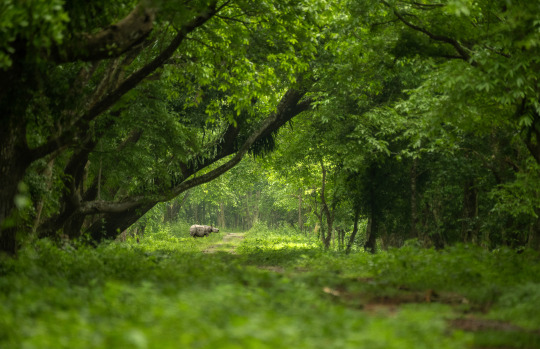
Rhino in lush green habitat - Kaziranga National park
#nature#best indian wildlife photographer#wild#indian wildlife#indian wildlife photographer#indian wildlife safari#wildlife photography#bird#wildlife#nature photography#rhino#kaziranga photo tour#kaziranga#wildlife photographer#animal photography#wild animals#big animal#animals#cute animals#baby animals
7 notes
·
View notes
Text
Wildlife Tour Package | All India Birding Tours
India, a land of incredible diversity and natural beauty, has long been a haven for wildlife enthusiasts and nature lovers. Among the best ways to explore these treasures are the breathtaking birding tours offered by Asian Adventures, a leading name in eco-tourism and wildlife exploration. In this blog, we delve into the enchanting world of All India Birding Tours, where every excursion is a journey of discovery and wonder.

Exploring India's Avian Paradise
Asian Adventures' All India Birding Tours are designed to showcase the rich avifauna of this vast and varied country. From the misty hills of the Himalayas to the sun-kissed shores of the Andaman Islands, each destination offers a unique glimpse into India's avian paradise.
Sasan Gir: A Wildlife Marvel
One of the highlights of Asian Adventures' birding tours is the opportunity to explore Sasan Gir in Gujarat. Known for its majestic Asiatic lions, Sasan Gir is also home to a remarkable variety of bird species. Imagine embarking on a dawn safari, with the golden light of sunrise illuminating the wilderness as you spot vibrant Indian Pittas, graceful Indian Paradise Flycatchers, and the elusive Indian Eagle-Owl.
Jungle Safaris: A Thrilling Encounter
No wildlife tour is complete without a jungle safari, and Asian Adventures ensures an unforgettable experience. Picture yourself cruising through dense forests and grasslands, binoculars at the ready as you scan the treetops for the elusive Malabar Trogon or the dazzling Plum-headed Parakeet. With expert guides leading the way, every safari is a thrilling encounter with India's untamed beauty.
Earth Walks: Immersed in Nature
For those seeking a more intimate connection with nature, Asian Adventures' Earth Walks offer a deeper insight into India's ecosystems. Stroll through lush greenery, listening to the melodious calls of birds overhead and learning about the intricate web of life that sustains them, all in and around your home city. These immersive one-day nature experiences are perfect for all kinds of people, including birders, photographers, families, and solo nature enthusiasts.
Conservation and Sustainability
Asian Adventures is not just about exploration; it's also committed to conservation and sustainability. Through responsible tourism practices, they strive to protect the habitats and species that make India's wildlife tours so extraordinary. By choosing Asian Adventures, you not only embark on a memorable journey but also contribute to the preservation of India's natural heritage.
The Asian Adventures Difference
What sets Asian Adventures apart is their passion for wildlife and dedication to providing exceptional experiences. With expert naturalists, comfortable accommodations, and meticulously planned itineraries, every aspect of their birding tours is designed to delight and inspire.
Embark on Your Wildlife Odyssey
Whether you're a seasoned birder or a nature enthusiast eager to explore, Asian Adventures' All India Birding Tours offer something for everyone. From the captivating beauty of migratory birds in Bharatpur to the rugged landscapes of Ranthambore, each destination beckons with its own charm and allure.
Book Your Adventure Today
Don't just dream of India's wildlife wonders; experience them with Asian Adventures. Book your All India Birding Tour and embark on a journey of discovery, excitement, and unparalleled natural beauty. Let every sighting, every moment in the wild, be a memory to treasure for a lifetime.
#indian wildlife tours#birding tours in india#india birding tours#wildlife and birding tours#family holiday packages in india
1 note
·
View note
Text
10 Reasons to Visit This Tropical Paradise
Discover Zanzibar
Zanzibar, an archipelago off the coast of Tanzania, is a tropical paradise renowned for its pristine beaches, rich history, and vibrant culture. Known as the "Spice Island," Zanzibar offers an enchanting blend of natural beauty and cultural treasures, making it a must-visit destination for travelers.
1. Pristine Beaches
Zanzibar is famous for its white sandy beaches and crystal-clear turquoise waters. These idyllic beaches are perfect for sunbathing, swimming, and a variety of water sports. Whether you're looking to relax on the shore or dive into adventure, Zanzibar's beaches cater to every preference.

2. Diverse Marine Life
The waters surrounding Zanzibar are teeming with diverse marine life, making it a haven for snorkeling and diving enthusiasts. Explore vibrant coral reefs and encounter dolphins, sea turtles, and exotic fish species in their natural habitat, providing an unforgettable underwater experience.

3. Rich History and Culture
Stone Town, a UNESCO World Heritage Site, is the cultural heart of Zanzibar. Wander through its narrow streets and historic buildings, where a blend of African, Arab, Indian, and European influences is evident in the architecture, cuisine, and traditions. Stone Town's rich history and cultural significance offer a fascinating glimpse into Zanzibar's past.
4. Spice Tours
Zanzibar's nickname, the "Spice Island," is well-deserved. Embark on a spice tour to discover the island's famous spice plantations, where you can learn about and taste cloves, cinnamon, vanilla, and more. These tours provide insight into Zanzibar's spice trade history and its impact on the local culture and economy.
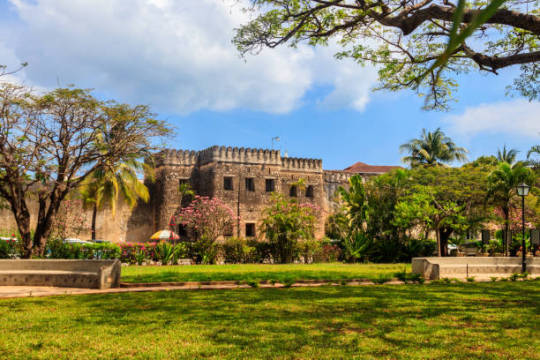
5. Unique Wildlife
Jozani Chwaka Bay National Park is home to the rare red colobus monkey, a species unique to Zanzibar. The park also offers opportunities to see diverse bird species and other wildlife in their natural habitats, making it a great destination for nature lovers and wildlife enthusiasts.
6. Water Activities
For adventure seekers, Zanzibar offers a range of thrilling water activities. Sail along the coast on traditional dhows, try kite surfing and windsurfing, or embark on a deep-sea fishing expedition. The island's coastal waters provide the perfect playground for both relaxation and excitement.

7. Local Cuisine
Zanzibar's cuisine is a delightful fusion of flavors, featuring fresh seafood dishes, tropical fruits, and aromatic spices. Savor traditional Zanzibari dishes like pilau rice, biryani, and seafood curries, and indulge in the island's vibrant food scene.
8. Relaxation and Wellness
Zanzibar's luxurious resorts and spas offer rejuvenating treatments and wellness programs. Enjoy yoga retreats and meditation sessions in serene natural surroundings, providing a perfect escape for those seeking relaxation and wellness.
9. Vibrant Markets
Explore Zanzibar's bustling markets, where you can find local crafts, textiles, and souvenirs. Interact with friendly locals and immerse yourself in the vibrant atmosphere, experiencing the island's lively market culture firsthand.

10. Sunset Views
End your day in Zanzibar with spectacular sunsets over the Indian Ocean. The breathtaking views provide a perfect backdrop for relaxation and reflection, offering a serene conclusion to a day of exploration.
Conclusion
Zanzibar is a tropical paradise that offers something for every traveler. From its pristine beaches and diverse marine life to its rich history and vibrant culture,https://plentifuladventures.com/ an unforgettable experience. Whether you're seeking relaxation, adventure, or cultural immersion, Zanzibar invites you to discover its beauty and charm. Plan your visit and experience the magic of this enchanting island destination.

#wild animals#ugandian knuckles#tourism#tourist#tour#the eras tour#Adventure#photography#beach#safari#africa#Nairobi#Uganda#Kenya#Masai Mara#beaches#Wanderlust#east africa#Travel Photography#travel blog#tanzania#tanned#zanzibar#tangled#tanzanite#kenyan#kenya moore#beachlife#Kenya Safari#travel
2 notes
·
View notes
Text
Things to do in Jensen Beach
Introduction
Jensen Beach, a hidden gem on Florida's Treasure Coast, attracts visitors with its relaxed charm and wide range of outdoor activities. Whether you're an experienced explorer or a family in search of tranquility, this coastal haven has something for all. To discover the delightful downtown area especially, think about renting a golf cart and meandering through the streets bordered by pastel cottages and local stores.

Beaches and Water Sports
No trip to Florida is truly complete without lolling in the sun on the beautiful beaches. Jensen Beach offers a variety of stunning shorelines, each with its charm. Walton Rocks Beach, a local gem, provides gentle waves ideal for families with young children and includes a special dog park so your furry mate can enjoy the beach too. For a more hidden retreat, visit Waveland Beach to relax under swinging palm trees and listen to the soothing sound of the ocean.
The real enchantment of Jensen Beach lies in its waterways. The Indian River Lagoon, a protected estuary overflowing with marine life, is a paradise for water lovers. Rent a kayak or paddleboard for a peaceful adventure through the mangrove forests. You may find playful dolphins, graceful manatees, and a variety of bird species. For an exciting experience, consider hiring a fishing boat to challenge your fishing abilities against the diverse marine life. The Indian River Lagoon is famous for its plentiful game fish, making it a must-visit destination for fishing enthusiasts.

Explore at Your Own Pace
The beaches are quite long in length, and I know you don’t want to walk all the way from your hotel to the beach. While exploring Jensen Beach, consider renting a golf cart for a unique and convenient way to navigate the town. Imagine cruising through the streets in a 4-seater golf cart in Jensen Beach, enjoying the fresh air and soaking in the sights at your own pace. This is particularly advantageous for families with young children or those who may find walking long distances challenging. Rental golf carts offer the freedom to explore hidden gems, charming shops, and tucked-away restaurants, all within the comfort of your electric vehicle.
Nature Trails and Parks
Jensen Beach is a haven for outdoor lovers. Discover the picturesque paths of Savannas Preserve State Park, a vast 5,000-acre sanctuary filled with a rich collection of plants and animals. Trek or cycle through the vibrant scenery, watching for gopher tortoises, sandhill cranes, and various bird species. To add a special touch, take a guided airboat tour through the mangroves. This exciting adventure offers a close look at the fragile ecosystem and provides insights into its significance.

A Touch of History and Culture
Jensen Beach offers more than sun, sand, and surf. Immerse yourself in the region's rich history with a visit to the Mansion at Tuckahoe, a meticulously restored historic landmark. Explore the beautifully preserved rooms and learn about the area's captivating past. For a touch of whimsy, head to the Artist Cottages, a charming enclave where local artists showcase their talents. Browse through vibrant paintings, handcrafted jewelry, and unique souvenirs, taking home a piece of Jensen Beach's creative spirit.
Sunset and Vibrant Nightlife
As the sun dips below the horizon, Jensen Beach transforms into a haven for relaxation. Enjoy a delicious seafood dinner at a waterfront restaurant, taking in the breathtaking views of the Indian River Lagoon. Downtown Jensen Beach comes alive in the evenings, with its charming boutiques and art galleries staying open late for relaxed browsing. Catch some live music at a local bar or enjoy a delightful performance of Music at the Mansion series, held at the historic Mansion at Tuckahoe.
Conclusion
Jensen Beach offers an unforgettable escape, catering to every traveller's desires. From action-packed water adventures to serene beach days and cultural exploration, this charming coastal town promises an experience that will leave you yearning for more. Don’t forget to go for a 4-person golf cart rental near you in Port St. Lucie to save your money on Uber or walking all day long on the roads. With wheels secured, you'll be cruising towards unforgettable memories in Jensen Beach in no time!
2 notes
·
View notes
Text









It's kind of selfish too. I just like it. I'm always looking for the new new shit."

Erykah has also collaborated with Italian fashion house Marni on a capsule collection which was sold in select Marni boutiques.
"Everything is vibration and sound, from the sound of the birds that I've heard since I was a child...(to) the clothes I wear - the clothes in my Marni line all have bells on them," the Dallas native said. "So, if I associate everything with music, it's very easy for me to create...there's a variety of things I listen to throughout the day, from wind chimes in the morning to Brent Faiyaz in the afternoon to Bach - I mean, there's just so many different things. I just love music and frequency. It is my therapy."
Badu describes the Marni collection as something of an audiovisual experience, what she calls "mystical instrumental wear."
A champion for Black women and free thought, she's not only in an era of reinvention, but expansion. She's entered the cannabis industry partnering with Cookies, arguably the world's most recognizable legal marijuana brand. She's worked with Cookies co-founder Berner to create a weed strain called That Badu, also working on a mushroom tea line.
Although it's been years since Badu put out an album, she has recently gone on tour, called The Unfollow Me tour. In an interview with Vibe, she revealed the inspiration for the name of the tour - cancel culture. "Whenever someone says something in the comments, they don't agree, I don't care, unfollow me, doesn't matter," she told the magazine.
"One thing I brag about all the time is that my sister is probably the only artist I know who easily sells out arenas despite not having put out an album in almost a decade," says sibling Koryan, or Koko for short. Koko once sang backup for Badu's band, but these days acts as her sister's right hand. With a trucker hat pulled over striking waist-length platinum blonde braids, Koko carries herself like a woman who means business. Badu's turning point, she explains, came when the pandemic brought touring to a halt.
The pivot was swift and effective: the launch of Badubotron, a streaming platform hosting concerts from Badu's home that could be viewed for the nominal fee of $1. These attracted more than a hundred thousand fans enamored of Badu's elaborate costumes, wild performances, and otherworldly DIY sets. In one of her shows, Badu and her band appeared to perform inside huge inflatable bubbles. The singer's popular online merch store, Badu World Market, also went live. "We just kind of came together as a family and it was like, Oh, we actually have a company right here," says Koko, whose son, Malcolm, and daughter, Diamond, also work for brand Badu. "Everyone stepped up."
The latest family member to join the team is Badu's daughter Puma. Listening to her cover her mother's songs on TikTok, you can barely tell their voices apart. She and boyfriend Sean have been serving as Badu's personal assistants for a little over a year, which means, among other things, ensuring Badu has the 15 to 20 trunks of clothing and accessories she needs on tour. "I don't know how other family workplace dynamics go," Puma says, "but it's like a real job, and I have to buckle down and do what I need to do or else word is going to get to the CEO and I'm not going to get paid. You know what I mean?"
Inside Badu's home, it's a veritable Aladdin's cave of tchotchkes and objets d'art, with Buddha statues lining the staircase, African masks hanging on the walls, and Indian marigold garlands strung in the windows. Badu, in a silk Libertine caftan printed with pictures of monkeys in space suits, leads her guests past her recording studio to the living area, where two larger-than-life Malian brass busts have glowing sticks of incense sprouting from their heads. The fireplaces casts shadows on vintage furniture, including a throne-like peacock love seat and a retro-futurist egg pod chair. In the corner, an upright piano is buttressed by a stack of vintage Louis Vuitton trunks.
2 notes
·
View notes